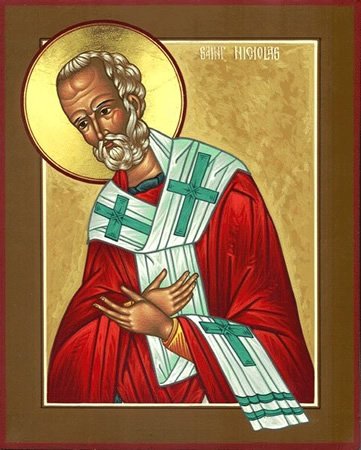 St. Nicholas of Myra is truly one of the most popular saints of our Church. Tradition maintains that he was born to well-to-do parents in the province of Lycia in the southern part of Asia Minor in the city of Patara. The precise date of his birth is unknown. Having inherited his parents’ estate, he became known for his generous gifts to those in need. As a youth, he made pilgrimages to Palestine and Egypt.
St. Nicholas of Myra is truly one of the most popular saints of our Church. Tradition maintains that he was born to well-to-do parents in the province of Lycia in the southern part of Asia Minor in the city of Patara. The precise date of his birth is unknown. Having inherited his parents’ estate, he became known for his generous gifts to those in need. As a youth, he made pilgrimages to Palestine and Egypt.
He is known to have been archbishop of Myra and he may have participated in the Council of Nicea in 325, even though his name does not appear on any of the documents from that Council. Little else is known about where he studied to become a priest or who even consecrated him.
Tradition tells us that he was imprisoned during the persecutions of Diocletian and released by Emperor Constantine. Nicholas was noted for his defense of the true faith against the Arians. He died in Myra on December 6th in a year uncertain, but between 342 and 352.
Many of the details of his life that we have appeared during medieval times. St. Methodius, Patriarch of Constantinople, in the middle of the ninth century, produced a life of Nicholas in which he noted that the life of Nicholas was unknown to most of the Christians of the time, thus indicating his composition was probably based mainly on legend. Methodius noted that Nicholas was raised well by pious and well-to-do parents and related how Nicholas contributed from his inheritance the dowry for three daughters of a citizen of Patara who had lost all his money.
His feast was celebrated by the time of St. Justinian, two centuries after his death. After Methodius’ life of Nicholas became available, Nicholas was acclaimed and honored throughout Europe and especially in Italy. When Myra was captured by the Saracens in 1034, many Italian cities planned to “rescue” his relics. In 1087, forces from Bari, Italy, attacked Myra and carried away his relics from the town of Myra to Bari where they were and are enshrined in a church. His fame increased. The story of his rescue of sailors in the Aegean Sea during his lifetime established him as the patron of mariners.
The sainthood of St. Nicholas’ pre-dates considerably the 1054 schism between the Eastern and Western churches. Although the 1969 revision of the Roman Catholic calendar has made his feast optional, his feast is maintained in the Eastern Church by both Catholic and Orthodox Christians.
As all are aware, our own Eparchy and Cathedral Church have St. Nicholas as a patron. By tradition, gifts were always given to loved ones, especially children, on the feast of St. Nicholas instead of on the feast of Christmas.
